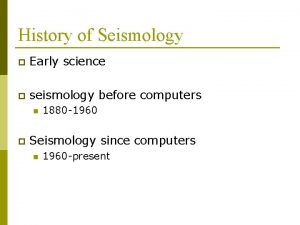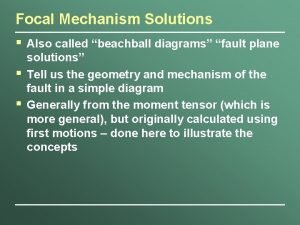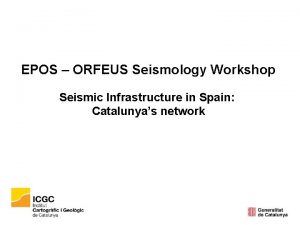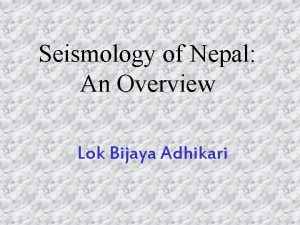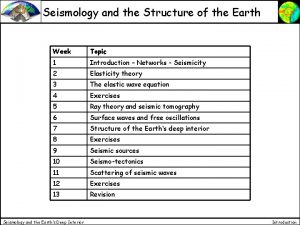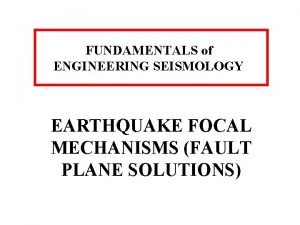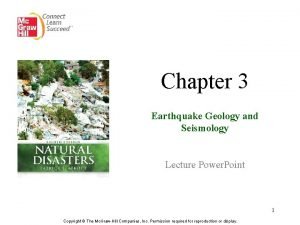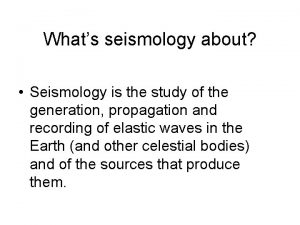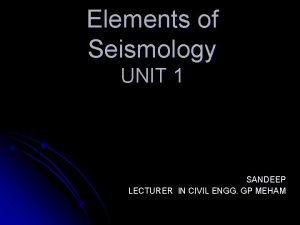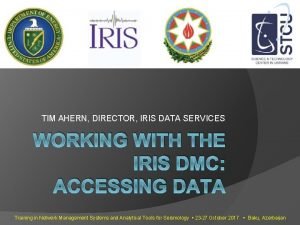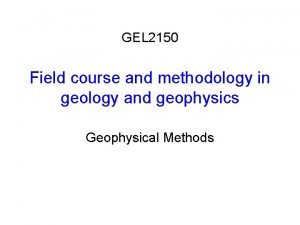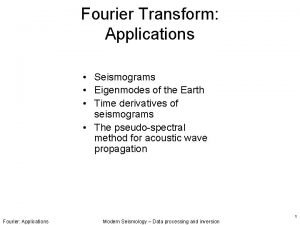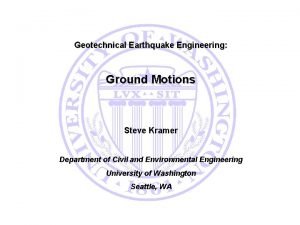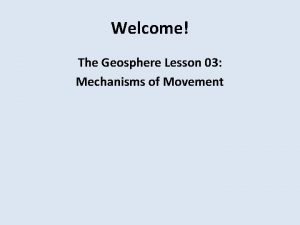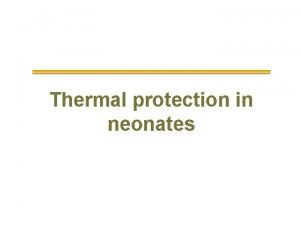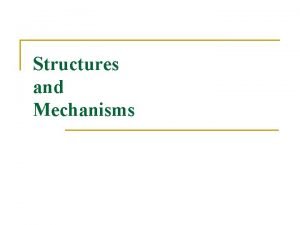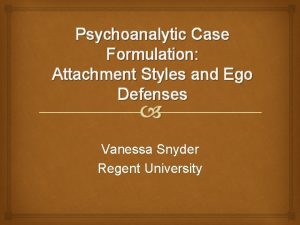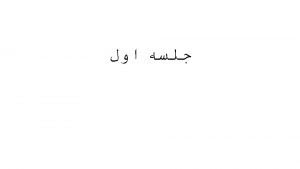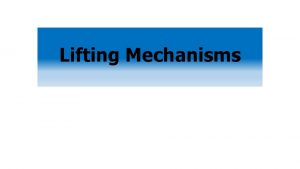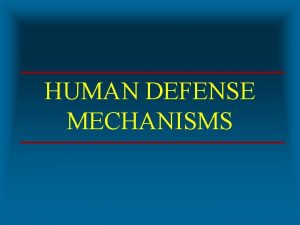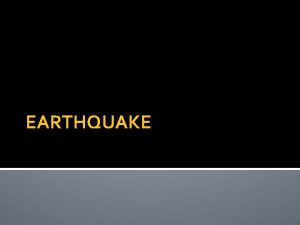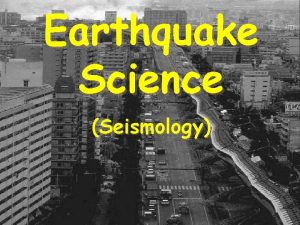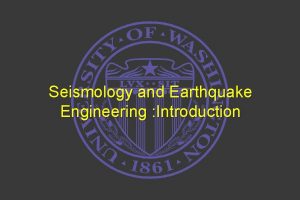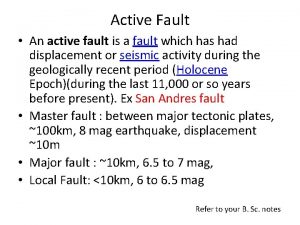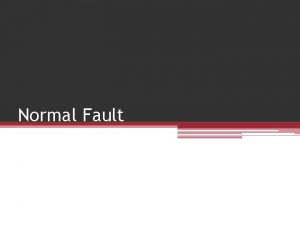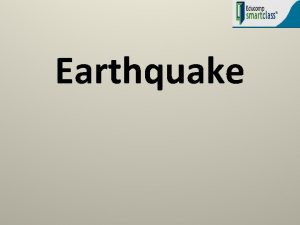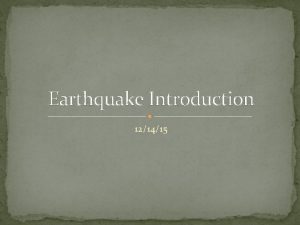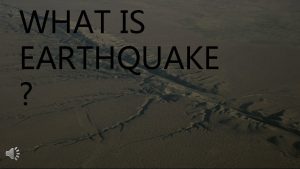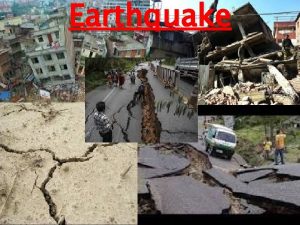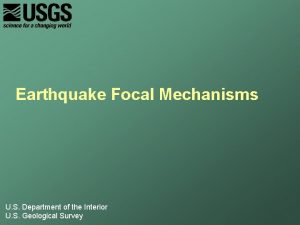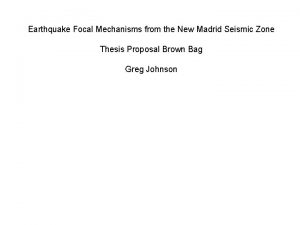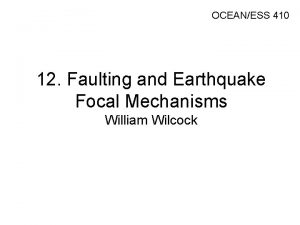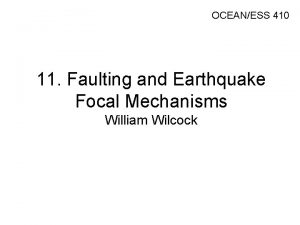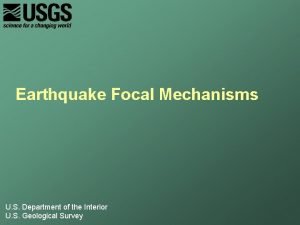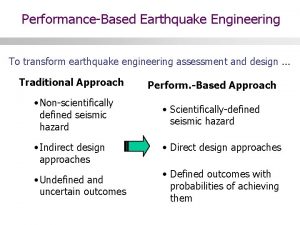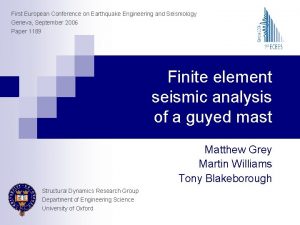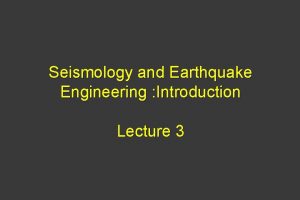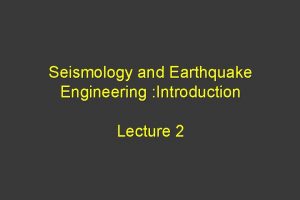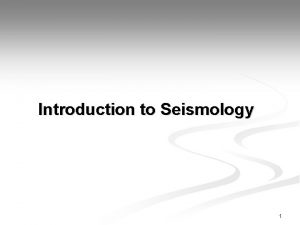FUNDAMENTALS of ENGINEERING SEISMOLOGY EARTHQUAKE FOCAL MECHANISMS FAULT













































- Slides: 45

FUNDAMENTALS of ENGINEERING SEISMOLOGY EARTHQUAKE FOCAL MECHANISMS (FAULT PLANE SOLUTIONS)

- Focal mechanisms: body wave radiation pattern - Focal mechanisms: stereographic fault plane representations Credits: -Some slides provided by Dino Bindi (INGV) and A. Kelly (USGS) -Cox and Hart. Plate Tectonics – How it works. -Stein and Wysession, An Introduction to seismology, earthquakes and Earth structure

Elastic rebound model of earthquakes assumes that between earthquakes, material on the two sides of a fault undergoes relative motion. Because the fault is locked, features across it that were linear at time (a), such as a fence, are slowly deformed with time (b). Finally the strain becomes so great the fault breaks in a earthquake, offsetting the features (time c). (Courtesy of S. Wesnousky) From S. Stein and M. Wysession

A minority of faults break the surface; how is the orientation of the fault plane and the direction of slip determined if the fault does not break to the surface?

To describe the geometry of a fault, we assume that the fault is a planar surface across which relative motion occurred during an earthquake. The fault is characterized by the normal vector n, while the slip in the fault plane is along the vector d. Several coordinate systems can be considered; one is aligned such that the x 1 axis is along the fault strike direction (intersection of the fault plane with the Earth surface); x 3 axis points upward; x 2 axis is perpendicular to the other two. The direction of x 1 is selected such that the dip of the plane with respect to -x 2 is less than 90 degrees. The direction of the motion is represented by the slip angle, l, measured counterclockwise in the fault plane from the x 1 direction. From S. Stein and M. Wysession

A very important figure describing sign conventions for focal mechanisms From S. Stein and M. Wysession

Seismograms recorded at different distances and azimuth are used to study the geometry of faulting during an earthquake, known as focal mechanism. This operation uses the fact that the pattern of radiated seismic waves depends of the fault geometry. There are several methods to infer the focal mechanism, such as the analysis of the polarity of the first arrivals or the inversion of waveforms. We discuss only the former approach (e. g. , see Introduction to Seismology by Stein and Wysession for details) The first P-wave arrival varies between stations at different directions from an earthquake. The first motion is either compression (motion toward the station) or dilatation (motion away from station). The first motion defines 4 quadrants, divided by the fault and the auxiliary planes (nodal planes). From S. Stein and M. Wysession

Focal Mechanism (Fault Plane Solution)

The seismic source is modelled as a point, but in reality it is rupture over a plane and relaxation over a volume… but, can use radiation pattern of first Pwaves to determine the focal mechanism at the hypocenter


The Centroid Moment Tensor is the most complete description of the forces acting on the fault rupture. If it is assumed that the fault rupture is PURE SHEAR (ie. , that it involves no volume change) then the model of the forces acting on an equivalent point source is reduced to a much simpler system known as a DOUBLE COUPLE.

Radiation from a shear dislocation with slip S over area A in material with rigidity μ is identical to that from a double couple.

Faulting & Compressional Waves P-wave radiation pattern

Earthquake on a vertical plane Edited from Cox and Hart. Plate Tectonics – How it works.

Determination of nodal planes Cox and Hart. Plate Tectonics – How it works.

N. B. The first motions from a slip on the actual fault plane and from a slip on the plane perpendicular to it (auxiliary plane) would be the same, so the first motions alone cannot resolve which plane is the actual fault plane. Additional information can often settle the question. Sometimes geologic or geodetic information indicates the fault. Often smaller aftershocks following the earthquake occur on, and thus delineate the fault plane. In other cases, for earthquakes large enough, source effects can be used to determine the fault plane (e. g. directivity effects can destroy the symmetry of the radiation pattern)

Data on the surface, interpreted in 3 D Courtesy of A. Kelly Cox and Hart. Plate Tectonics – How it works.


To determine the fault plane solution using the first motions, the observations at stations (Earth surface) have to be converted to observations over a sphere (of infinitesimal radius) around the source. The position on the sphere is determined by the take-off angle (computed from the slope of the travel-time curve). A. Kelly, USGS azimuth S. Stein and M. Wysession D. Boore

Determining the focal mechanism from P-wave first motions • Use azimuth and take off angle to determine where the Pwave intersects a sphere around the source • Plot those points of intersection on a stereographic projection, using a filled circle (or +) for compressions and an open circle for dilatations • Determine the two possible fault planes

P-wave first motions from 1989 Loma Prieta earthquake. Compressions are +. Lines divide stereonet into quadrants of compression and dilation. Strike=130, dip=70. Note: Because of symmetry, focal mechanism cannot distinguish fault plane from auxiliary plane. The two planes must be perpendicular to one another (how do you check this in the projection? ). Note some inconsistencies; this is to be expected when working with real data.

Seismic “Beach Balls” • Project the pattern of initial motions intersecting an imaginary sphere around the source (the “focal sphere”) onto a flat surface. • We use the radiation patterns of P-waves to construct a graphical representation of earthquake faulting geometry (two planes intersecting one another at right angles) • The symbols are called “Focal Mechanisms” or “Beach Balls”, and they contain information on the fault orientation and the direction of slip.

Focal Mechanism • When mapping the focal sphere to a circle (beachball) two things happen: – Lines (vectors) become points – Planes become curved lines

Stereographic projection • A method of projecting half a sphere onto a circle. • e. g. planes cutting vertically through the sphere plot as straight lines Courtesy of A. Kelly Images from http: //www. learninggeoscience. net/free/00071/index. html

Focal mechanisms: Shown by stereographic projection. Graphic shows stereographic projection of a fault plane (2 D projection of plane onto focal sphere) This is a lower hemisphere projection

-Azimuths are along the great circle -Dip angles are along the equator -NS-striking Planes with different dip are meridians From S. Stein and M. Wysession

If the plane is striking in other azimuths, they can be displayed by rotating the stereonet E. g : strike 45° , dip 60° First rotate the steronet such that the strike 45° is vertical. Then, select the meridian corresponding to 60°. Finally, rotate back the stereonet. From S. Stein and M. Wysession

Courtesy of A. Kelly

To plot a point, the procedure is the same. E. g. station with azimuth 40° and take-off 60° Rotate the stereonet of 40° clockwise (the equator is along azimuth 40°). Select the dip=30° (remember, take-off are measured with respect to vertical, dip with respect to horizontal dip=90 -take-off). Then, turn back the stereonet From S. Stein and M. Wysession

Focal Mechanisms • Beachballs always have two curved lines separating the quadrants. That means that beachballs show two planes. • But there is only one fault plane. • The other plane is called the auxiliary plane. • The planes are orthogonal. • Seismologists cannot tell which is which from seismograms alone, so we always show both of the possible solutions.

Azimuth of these fault planes all strike north, with dips as shown. Rotate stereonet for other strike azimuths. Projection of the normal to the plane; the auxiliary plane must go through this point. Does this define a unique auxiliary plane?

Same N-S fault, different slip direction Stein and Wysession, An Introduction to seismology, earthquakes and Earth structure

+ - + Normal dip-slip fault + Reverse dip-slip fault

Fault types and “Beach Ball” plots USGS

Stein and Wysession

The Principal Mechanisms which is the fault plane?

Focal Mechanisms • It is often possible to make an educated guess as to which of the two possible planes is the actual fault plane: – Normal earthquakes – work with gravity so are often steep – Thrust events – work against gravity so are often shallow

Focal Mechanisms • For strike slip focal mechanisms we can often determine the fault plane by its orientation with respect to the fault. Plate A Plate B (right or left lateral ? ? ) Ridge

Summary of focal mechanism concepts • Direction of first motions (up, down) can be used to divide focal sphere into quadrants of compression and dilation (stereographic projection). • The planes separating these quadrants are the fault plane and its auxiliary plane (at 90 degrees to fault plane). The planes are orthogonal. • Thus first motions can be used to determine fault orientation (provided we can find some information to distinguish fault plane from auxiliary plane).

Summary • The focal mechanism of an earthquake is a graphical description of the type of faulting • Although the fault type can be determined from seismograms, the particular fault plane cannot be determined. • There always 2 possibilties: – The real plane, known as the fault plane – The fake plane, known as the auxiliary plane

Summary • The fault plane can be distinguished from the auxiliary plane by considering: – The steepness of the fault • Reverse = shallow • Normal = steep – Nearby morphological features • The strike of the transform segment for instance – The distribution of aftershocks • Aftershocks tend to line up along the fault plane (but not always of course) – Directivity effects on the waveforms

Faulting and Plate Tectonics

Stein and Wysession

Stein and Wysession

End
 Seismology timeline
Seismology timeline Beach ball diagram
Beach ball diagram Orfeus seismology
Orfeus seismology Seismology nepal
Seismology nepal Seismology
Seismology Beach ball seismology
Beach ball seismology Seismology
Seismology Whats seismology
Whats seismology Elements of seismology
Elements of seismology Seismology
Seismology Seismology
Seismology Seismology
Seismology Geotechnical earthquake engineering kramer
Geotechnical earthquake engineering kramer Electrical engineering fundamentals (66712)
Electrical engineering fundamentals (66712) Electrical engineering fundamentals 66712 pdf
Electrical engineering fundamentals 66712 pdf Design principles in software engineering
Design principles in software engineering Fundamentals of industrial engineering
Fundamentals of industrial engineering Mechanisms of movement lab report
Mechanisms of movement lab report Tools and mechanisms of virtualization
Tools and mechanisms of virtualization Mischel's theory
Mischel's theory Countercurrent exchange thermoregulation
Countercurrent exchange thermoregulation Evaporative heat loss newborn
Evaporative heat loss newborn The psychodynamic perspective
The psychodynamic perspective Th and tc cells
Th and tc cells Behaviorist theory of personality
Behaviorist theory of personality Circular motion examples
Circular motion examples How does sponges protect itself from predators
How does sponges protect itself from predators Pay per use monitor
Pay per use monitor Ego defenses
Ego defenses Different types of pop up mechanisms
Different types of pop up mechanisms Rationalization defense mechanism
Rationalization defense mechanism Examples of defence mechanism
Examples of defence mechanism Ego defense mechanisms
Ego defense mechanisms Psychoanalytic perspective of personality
Psychoanalytic perspective of personality Transverse lie
Transverse lie Ap psychology defense mechanisms worksheet answers
Ap psychology defense mechanisms worksheet answers 3 mechanisms of microevolution
3 mechanisms of microevolution Portal circulation
Portal circulation Mechanisms of evolution
Mechanisms of evolution Genetic drift vs gene flow vs natural selection
Genetic drift vs gene flow vs natural selection Lever linkage mechanisms
Lever linkage mechanisms In this unit you learned to
In this unit you learned to Freuds theories
Freuds theories Synectic trigger mechanism
Synectic trigger mechanism Categories of defense mechanisms
Categories of defense mechanisms Conduction heat loss newborn
Conduction heat loss newborn
